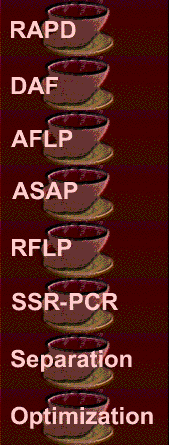(1) Hybridization-based techniques:
- Multi-locus minisatellite fingerprinting (Jeffreys et al., 1985)
- Oligonucleotide fingerprinting (Ali et al. 1986; Weising et al. 1991)
- Restriction fragment length polymorphism (RFLP) (Wyman and White 1980, Botstein et al.1980)
(2) Amplification-based nucleic acid scanning techniques:
- Random amplified polymorphic DNA (RAPD) (Williams et al. 1990)
- Arbitrarily primed PCR (AP-PCR) (Welsh and McClelland 1990)
- DNA amplification fingerprinting (DAF) (Caetano-Anollés et al. 1991)
- Minihairpin primer-driven DAF (mhpDAF) Caetano-Anollés and Gresshoff 1994)
- Arbitrary signatures from amplification profiles (ASAP) (Caetano-Anollés and Gresshoff 1996)
- AFLP (Vos et al. 1995)
- Alu-PCR (Nelson et al. 1989)
rep-PCR (Versalovic et al. 1994) - Microsatellite-primed PCR (MP-PCR) (Meyer et al. 1993; Perring et al. 1993)
- Anchored MP-PCR (AMP-PCR) (Zietkiewicz et al. 1994)
- Random amplified microsatellite polymorphism (RAMP) (Wu et al. 1994)
- Random amplified hybridization microsatellites (RAHM) (Cifarelli et al. 1995, Richardson et al. 1995; Ender et al. 1996)
- Nucleic acid scanning-by-hybridization (NASBH) (Salazar and Caetano-Anollés 1996)
- RAPD dot-blot hybridization (Penner et al. 1996)
- Differential display reverse transcription (DDRT) PCR (Liang and Pardee 1992)
- RNA arbitrarily primed PCR (RAP-PCR) (Welsh et al. 1992)
- cDNA-AFLP (Bachem et al. 1996)
(3) Amplification-based nucleic acid profiling techniques:
- Amplified fragment length polymorphism (AmpFLP) (Jeffreys et al. 1988, Horn et al. 1989; Boerwinkle et al. 1989)
- Minisatellite variant repeat PCR (MVR-PCR) (Jeffreys et al. 1991)
- Simple sequence repeat PCR (SSR-PCR) (Litt and Luty 1989, Weber and May 1989, Tautz 1989)
(4) Sequence-targeted techniques:
- Allele specific oligonucleotide (ASO) hybridization (Saiki et al. 1986)
- TaqMan ASO (Livak et al. 1995)
- Allele specific reverse dot blot hybridization (Keller et al. 1991)
- Single strand conformation polymorphism (SSCP) (Orita et al. 1989)
- Cleaved amplified polymorphic sequence (CAPS) analysis (Konieczny and Ausubel 1993)
- Coupled amplification and sequencing (CAS) (Ruano and Kidd 1991)
- Amplification refractory mutation system (ARMS) (Newton et al. 1989)
- Oligonucleotide ligation assay (OLA) (Landegren et al. 1988, Nickerson et al. 1990)
- Coupled amplification and oligonucleotide ligation (CAL) (Eggerding 1995)
- Genetic bit analysis (GBA) (Nikiforov et al. 1994)
- Oligonucleotide arrays (reviewed in Southern 1996)
Notes: AFLP has been dubbed amplified restriction fragment polymorphism analysis. RAHM includes variants such as RAMPO (random amplified microsatellite polymorphism analysis) and RAMS (randomly amplified microsatellites). SSR-PCR is also known as sequence tandem repeat PCR (STR-PCR) or sequence-tagged microsatellite site (STMS) analysis.

